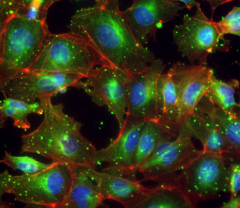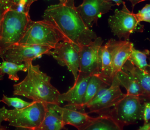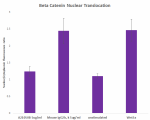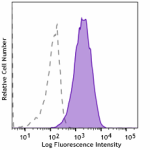- Clone
- A21050B (See other available formats)
- Regulatory Status
- RUO
- Other Names
- GPC4
- Isotype
- Mouse IgG2b, κ
- Ave. Rating
- Submit a Review
- Product Citations
- publications

-

The human embryonal carcinoma cell line NTERA-2 was grown on 96-well plates with a coverslip bottom and were fixed with Fixation Buffer (Cat. No. 420801) for 30 minutes. Cells were washed twice with PBS and stained with 5 µg/mL Ultra-LEAF™ purified anti-human Glypican-4 (clone A21050B) followed by Alexa Fluor® 488 anti-mouse IgG (green). Filamentous Actin was stained with Flash Phalloidin Red 594 (Cat. No. 424203). Nuclei were counterstained with DAPI (blue) (Cat. No. 422801). Cells were imaged using a 20x objective. -

The human embryonal carcinoma cell line NTERA-2 was grown on 96-well plates with coverslip bottom. Cells were treated with 5 µg/mL of Ultra-LEAF™ purified anti-human Glypican-4 (clone A21050B) or mouse IgG2b, κ isotype control or left untreated (Wnt3a-only control). After 15 minutes, cells were stimulated with 200 ng/mL recombinant human Wnt3a for 3h or left unstimulated. Cells were fixed using Transcription Factor Fix working solution for 30 minutes and washed twice with True-Nuclear™ Transcription Factor Buffer Set (Cat. No. 424401). Cells were then stained with purified anti-β Catenin (CTNNB1) (Cat. No. 844601) followed by Alexa Fluor® 594 anti-mouse IgG. Fluorescence intensity in the cytoplasm and the nucleus was quantified using ImageJ, and the nuclear/cytoplasmic fluorescence ratio calculated. -

The human embryonal carcinoma cell line NTERA-2 was stained with Ultra-LEAF™ purified anti-human Glypican-4 (clone A21050B) (filled histogram) or mouse IgG2b, κ isotype control (open histogram) followed by anti-mouse IgG PE.
| Cat # | Size | Price | Quantity Check Availability | Save | ||
|---|---|---|---|---|---|---|
| 386403 | 100 µg | 288€ | ||||
| 386404 | 1 mg | 964€ | ||||
Glypican-4 is a cell surface heparan sulfate proteoglycan that contains a core protein anchored to the cytoplasmic membrane via a GPI anchor. Glypicans function as coreceptors for a variety of growth factors including Wnt, bone morphogenetic proteins (BMPs), fibroblast growth factors, and Hedgehog. In particular, Glypican-4 enhances the Wnt3a dependent β-catenin pathway and the Wnt5a-dependent non-canonical Wnt signaling. Glypican-4 plays a role in the control of cell division and growth regulation and is upregulated in pancreatic cancer and colorectal cancer where it is involved in promoting chemoresistance. Glypican-4 also regulates glutamatergic synapse formation and function in the developing brain.
Product DetailsProduct Details
- Verified Reactivity
- Human
- Antibody Type
- Monoclonal
- Host Species
- Mouse
- Immunogen
- AA 23-529
- Formulation
- 0.2 µm filtered in phosphate-buffered solution, pH 7.2, containing no preservative.
- Endotoxin Level
- Less than 0.01 EU/µg of the protein (< 0.001 ng/µg of the protein) as determined by the LAL test.
- Preparation
- The Ultra-LEAF™ (Low Endotoxin, Azide-Free) antibody was purified by affinity chromatography.
- Concentration
- The antibody is bottled at the concentration indicated on the vial, typically between 2 mg/mL and 3 mg/mL. To obtain lot-specific concentration and expiration, please enter the lot number in our Certificate of Analysis online tool.
- Storage & Handling
- The antibody solution should be stored undiluted between 2°C and 8°C. This Ultra-LEAF™ solution contains no preservative; handle under aseptic conditions.
- Application
-
ICC - Quality tested
FC, Block - Verified - Recommended Usage
-
Each lot of this antibody is quality control tested by immunocytochemistry. For immunocytochemistry, a concentration of 5.0 μg/mL is recommended. For flow cytometric staining, the suggested use of this reagent is ≤ 1.0 µg per million cells in 100 µL volume. For blocking Glypican-4 mediated Wnt signaling in vitro, a concentration range of 0.1 – 5.0 μg/mL is suggested.
- Application Notes
-
This antibody blocks Glypican-4 mediated Wnt3a signaling in vitro at concentrations from 0.1 - 5.0 µg/mL.
- RRID
-
AB_3083388 (BioLegend Cat. No. 386403)
AB_3083388 (BioLegend Cat. No. 386404)
Antigen Details
- Structure
- Cell surface heparan sulfate proteoglycan
- Distribution
-
Cell membrane and nucleoplasm
- Function
- Enhances Wnt signaling by acting as R-spondin co-receptor
- Interaction
- PICK1, Insulin Receptor, Wnt3a, FGF2
- Ligand/Receptor
- Wnt3a
- Cell Type
- Neurons
- Biology Area
- Cell Biology, Cell Proliferation and Viability, Neurodegeneration, Signal Transduction
- Molecular Family
- APP/Aβ Degradation
- Antigen References
-
- Sakane H, et al. 2012. J Cell Sci. 125:449-60.
- Hagihara K, et al. 2000. Developmental Dynamics. 219:353-67.
- Watanabe K, et al. 1995. J Cell Biol. 130:1207-18.
- Ussar, S. et al. 2012. Diabetes. 61:2289-98.
- Gene ID
- 2239 View all products for this Gene ID
- UniProt
- View information about Glypican-4 on UniProt.org
Related FAQs
- Do you guarantee that your antibodies are totally pathogen free?
-
BioLegend does not test for pathogens in-house aside from the GoInVivo™ product line. However, upon request, this can be tested on a custom basis with an outside, independent laboratory.
- Does BioLegend test each Ultra-LEAF™ antibody by functional assay?
-
No, BioLegend does not test Ultra-LEAF™ antibodies by functional assays unless otherwise indicated. Due to the possible complexities and variations of uses of biofunctional antibodies in different assays and because of the large product portfolio, BioLegend does not currently perform functional assays as a routine QC for the antibodies. However, we do provide references in which the antibodies were used for functional assays and we do perform QC to verify the specificity and quality of the antibody based on our strict specification criteria.
- Does BioLegend test each Ultra-LEAF™ antibody for potential pathogens?
-
No, BioLegend does not test for pathogens in-house unless otherwise indicated. However, we can recommend an outside vendor to perform this testing as needed.
- Have you tested this Ultra-LEAF™ antibody for in vivo or in vitro applications?
-
We don't test our antibodies for in vivo or in vitro applications unless otherwise indicated. Depending on the product, the TDS may describe literature supporting usage of a particular product for bioassay. It may be best to further consult the literature to find clone specific information.
Other Formats
View All Glypican-4 Reagents Request Custom Conjugation| Description | Clone | Applications |
|---|---|---|
| Ultra-LEAF™ Purified anti-human Glypican-4 | A21050B | ICC,FC,Block |
Compare Data Across All Formats
This data display is provided for general comparisons between formats.
Your actual data may vary due to variations in samples, target cells, instruments and their settings, staining conditions, and other factors.
If you need assistance with selecting the best format contact our expert technical support team.

 Login / Register
Login / Register 











Follow Us